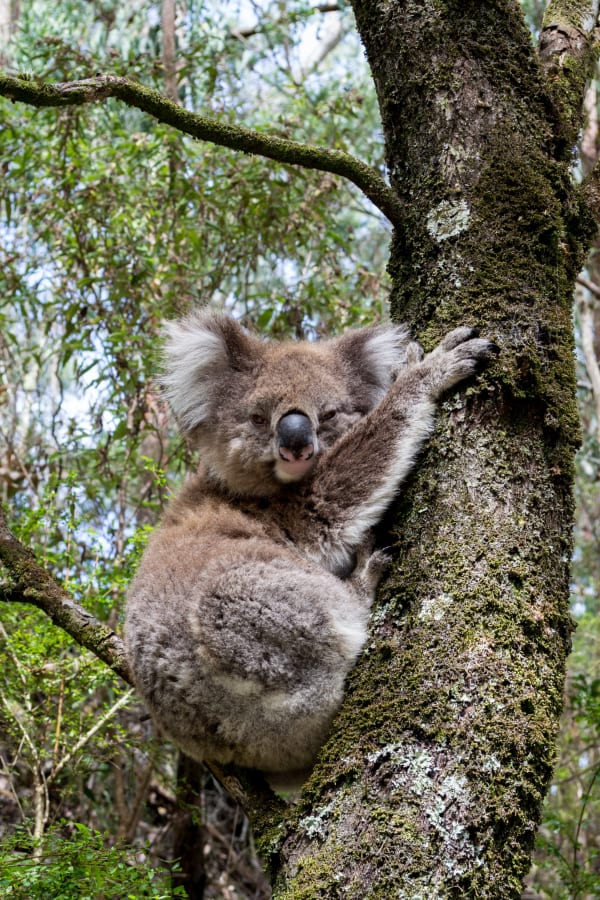A new network is hoping to help save koalas from extinction in the wild.
Founded by the non-profit Total Environment Centre and funded by rescue organisation WIRES, the Sydney Basin Koala Network aims to unite local groups and citizen scientists, protect and expand koala habitat and support conservation research.
“[Total Environment Centre and WIRES] have come together at a really important time when we are facing the extinction of the koala to say, ‘Hang on, the public needs to be aware, people in the Illawarra, for example, need to be aware that we have to do something’,” said koala activist Michael Organ, an Illawarra historian and former Greens Member for Cunningham.
As part of its launch, the Sydney Basin Koala Network surveyed more than 1000 residents across NSW about their knowledge of koala conservation and the marsupial's risk of extinction, finding that less than a third of respondents were aware that koalas live in nearby bushland.
In the Illawarra that statistic is likely to be much lower, Michael said.
“Most people on the coastal plain are totally oblivious to the fact that there’s koalas living right next to them,” he said.
“I grew up in Bulli and I was totally oblivious.”
After learning that the first koala to be scientifically examined in Australia was found on Mount Kembla in 1803 – 15 years after the arrival of the First Fleet – Michael felt as though the Illawarra was a little-known home of the marsupial. So began his fascination with their connection to our region and the Dharawal people and, in 2008, Michael contributed to a historical biography of the koala put out by CSIRO Publishing and participated in the 2013 YouTube documentary 'In Search of the Illawarra Koala'.
Michael said people don’t know that koalas are living in the Illawarra escarpment and its neighbouring catchments because no research has been done in the area, and this has made their decline seem like a faraway issue.
“There’s been no surveys, no studies of koalas there, there’s been nothing,” Michael said.
West of the Illawarra escarpment are two key catchment areas: the Woronora catchment covers 75 square kilometres at the northern end of the Illawarra Plateau, while the vast Upper Nepean catchment covers almost 900 sq km of bushland at the southern end.
“In the catchment area, it’s like a no-go zone for any sort of environmental issue… and in my view that’s a political issue, and it should not be,” Michael said.
“We’ve got a university next door to it, we’ve got the Department of Planning and Environment, we’ve got the National Parks and Wildlife Service – they all operate around the edges there, but none of them have actually gone in there and bothered to survey.”
As well as conducting surveys in our area, federal, state and local governments need to take more preventative action if koala populations are to survive, Michael believes.
“If they don’t do something, koalas will become extinct,” he said.
In June 2020, the winter after the Black Summer bushfires killed an estimated one billion animals, a NSW parliamentary inquiry found that koalas could be extinct in the state by 2050. In May 2022, the government declared koalas an endangered species on Australia’s east coast, upgrading their conservation status from vulnerable in NSW, Queensland and the ACT.
“What they should do is at all levels, at the federal level, which has legislation – but it’s a toothless tiger, their legislation – [as well as] at the state government level and at the local government level [is] say, ‘Look, we are really going to make an effort to create spaces wherever koalas can survive.'
“I think a great idea would be to declare the catchment area a koala reserve, a koala protection area, and I firmly believe that it would have no impact at all on water-quality issues [or] on coal mining.
“It would serve as, say, the kind of ark; it’s a large area where we know we could help expand the colonies, so that if there are bushfires, floods, disease, et cetera, the Illawarra catchment area [and] the Illawarra escarpment is an area where we know that koalas can survive.”

The Sydney Basin Koala Network aims to increase public awareness of koala protection strategies, engage with NGOs and experts and lobby against urban and mining developments that decimate koala habitat.
Michael said: “It’s quite clear that we are the problem in many ways; whether it’s our development, whether it’s our need for supply, whether it’s our pet animals… and so it’s also up to us to come up with a solution.
“What the Sydney Basin Koala Network is trying to do is to raise the profile of this issue, to make people think, ‘Okay, I live in Keiraville; or I live in Bellambi; I live in Dapto; I live in Port Kembla; if I just look to the west, there’s koalas up there, [but] the koalas are facing extinction.'
“I think if we could say to the people of the Illawarra and Wollongong that this is our issue as well [and] we have to play a part in staving off the extinction of the koala.”
For information about what you can do to help with koala conservation, visit the Sydney Basin Koala Network website.






